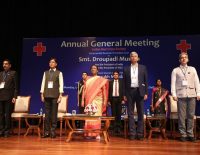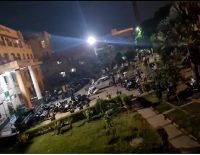Rare eye-cancer treated via Innovative Therapy at Fortis Gurugram

In a significant medical achievement, a team of doctors at Fortis Memorial Research Institute, Gurugram, successfully treated a 31-year-old woman with a rare and malignant left eye tumour, known as Choroidal Melanoma. This type of cancer has a global incidence rate of only 5-7 cases per million. Though rare, Choroidal Melanomas are known to spread to other parts of the body, even when small, Thus need urgent treatment. The patient underwent Plaque Brachytherapy, a specialized treatment for retinal eye tumour. This is the first case where this technique has been used in a private hospital in the Delhi-NCR region. Under the expert guidance of Dr. Anita Sethi, Director & HOD, Ophthalmology at Fortis Memorial Research Institute, the complex procedure was completed and, the patient was discharged in a stable condition with improved vision in just 5 days.
Upon her admission to the hospital, the patient presented with a six-month history of blurred vision in her left eye. While her right eye had normal vision (6/6), the left eye’s vision had deteriorated to 6/18. Medical examination revealed Stage 1a (early-stage) of the cancer, the lesion was 6–7-disc diameters in size, and was encroaching onto the macula). Given the tumour’s proximity to the Optic Nerve and the need to limit radiation exposure to the rest of the retina, Plaque Brachytherapy was chosen as the treatment method. This technique employs a small, silver-covered disc-shaped device, containing a radioactive source, to emit targeted radiation directly at the tumour, minimizing its spread to surrounding tissues. This method was particularly effective in this case as it allowed for the preservation of vision, despite the tumour’s critical location near the Optic Nerve.
Giving details of the case, Dr Anita Sethi, Director & HOD, Ophthalmology, Fortis Memorial Research Institute, Gurugram said, “We used an indigenous notched Ruthenium 106 Plaque made from radioactive waste. This complex procedure involves surgically placing the Radioactive plaque directly over the tumour within the eye, typically done under general anaesthesia. This plaque emits Beta radiation which targets the cancer cells without affecting the surrounding tissues. Alternatively, surgery would involve removing part or all of the eye so this procedure has the advantage of possibly saving vision in the eye. An alternative treatment, enucleation, involves removing the eye, which not only results in complete vision loss but also has cosmetic implications. Our approach with Plaque Brachytherapy was to preserve the eye’s functionality and appearanceof this young lady, while effectively treating the tumour.”
“Plaque brachytherapy is performed in two steps- firstly surgery for plaque insertion and then surgery for plaque removal. The duration required for the plaque to be in contact with the tumour is decided by Dosimetry (the science by which radiation dose is determined by measurement, calculation, or a combination of measurement and calculation). Dosimetry is done with the help of the radiation physicist and is based on the dimensions of the tumour and the radioactivity of the plaque. In our case we used a notched Ruthenium 106 Plaque and the total time required for completing both the steps was around 75 hours,” Dr Sethi added.








Comments